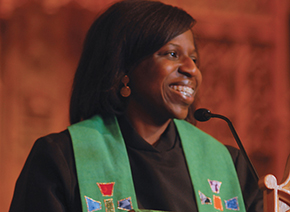Cultivating a holy imagination: Ministry in the 21st century

What is pastoral ministry like these days, and how is it being shaped in new ways? The Century talked to pastors about the challenges and surprises of their early years in ministry. This interview is the eleventh in a series. Lisa Yebuah attended Duke Divinity School. She is pastor of inviting ministries at Edenton Street United Methodist Church, a large, 200-year-old congregation in downtown Raleigh, North Carolina.
What excites you most about ministry these days?
There’s an amazing group of young people within our church family. They’ve shared with the clergy their holy restlessness about God’s call upon their lives. It’s a treasure to watch how God is moving through our student ministry, and it’s inspiring to listen to the ways these youth narrate their “Samuel stories.” When they recount the moment that God’s glory broke into and interrupted their ordinary lives, I feel confident that the church of Jesus Christ will continue to have faithful messengers stewarding the good news. This excites me.
Read our latest issue or browse back issues.
Can you share one of these Samuel stories?
I’m particularly invested in one young woman. She’s bright, engaging and wise. I was thrilled to have her intern with the inviting ministries team during her senior year of high school.
The afternoon she stopped by my office to talk about the internship, I finally asked her the question many of us had been wondering: Do you think God is calling you into ministry?
 Immediately she began to narrate her spiritual autobiography, starting with the day she was baptized as an infant in our church. She described the great impact of being cared for by nursery workers and Sunday school teachers. She reflected on the moments when mission trips stretched her understanding of God’s power in the world and of Christ’s power working within her. She recalled seeing with new eyes and hearing with new ears, experiencing the world in ways she had not before. And recent opportunities to assist in Sunday worship had unearthed her God-breathed gifts.
Immediately she began to narrate her spiritual autobiography, starting with the day she was baptized as an infant in our church. She described the great impact of being cared for by nursery workers and Sunday school teachers. She reflected on the moments when mission trips stretched her understanding of God’s power in the world and of Christ’s power working within her. She recalled seeing with new eyes and hearing with new ears, experiencing the world in ways she had not before. And recent opportunities to assist in Sunday worship had unearthed her God-breathed gifts.
I just listened as her God-life spewed out of her mouth—seemingly disparate experiences, but held together with tears and overwhelming emotion. This young woman put into words that intangible thing God does to us when God takes hold of our lives and we can’t shake loose. It was beautiful. And we both knew that the answer to my initial question was yes.
What’s been most surprising about ministry?
I think I worried that over time I would become numb or indifferent to pastoral situations. But it turns out that watching God breathe new life onto the dry bones in my parishioners’ lives doesn’t get old. In fact, each breakthrough I witness generates the same level of excitement and anticipation I have on Easter Sunday.
I have a front-row seat when a person’s life becomes the template for God’s resurrection power. I never imagined how much this would impact my own life. Sometimes when I’m journeying through my own valley of dry bones, I remember how God moved in someone else’s life, and this makes it easier to believe that God is able to do the same with mine.
What’s been the hardest part of ministry?
No level of preparation could have made me ready to handle the difficulty of living a life that’s not my own. It belongs to the church. And as much as I love what I do, the rhythms of parish ministry can be relentlessly demanding. I can’t thwart ministry’s interruptions, its pace, its crises or its tyranny of busyness. I can’t bargain with the seasons of loneliness or talk down the voices in my head that question my adequacy to handle holy things. I can’t always find the words to explain why my life is messy and wonderful all at the same time. God’s grace alone makes these difficult moments bearable.
Your life “belongs to the church”—are there appropriate limits to this attitude?
Definitely. I couldn’t thrive without limits, and without them it’d be too easy to try to play God. Sabbath-keeping reminds me of my humanity and finitude—and it reminds me to abide in a creating God who is infinite and who has an unfailing ability to do what I cannot. Sabbath-keeping recalibrates life when the “it belongs to the church” thing is off-kilter.
I think most of us pastors understand that Sabbath-keeping is for others’ good as well as our own. But it’s still extremely difficult to claim the gift of rest. Early in ministry, I always tried to earn the chance to take a day off. But I never felt like I’d worked enough. More than once this put me on the brink of burnout. I’m much better now at protecting and guarding my time, and it’s made all the difference in how I honor the work and the people God has entrusted to me.
How have pastors and others with more experience been helpful?
I deeply appreciate the seasoned pastors around me who model and live abundant lives—lives filled to the brim with joy, good eating, lots of fellowship, healthy relationships and interests outside the church. Their lives are tangible reminders that it is possible to possess a life marked with beauty despite the life-draining aspects of ministry. That’s an invaluable gift to witness. Seeing my colleagues really living inspires me to hold fast to my visions of a full and abundant life.
How have others proved unhelpful?
I am very intentional about limiting the time I spend with pastors who are skilled naysayers—the kind of clergy who have lost all hope or who believe nothing is possible. Their negative commentary can stir up a crippling dose of anxiety and self-doubt.
Who has shaped your understanding of ministry?
I spent the summer before my last year in seminary in South Africa, where Alan Storey was one of my mentors. He stretched my imagination about the church, encouraged me to take risks and gave me new eyes for reading scripture.
Tell us more about what you learned from him.
Alan pushed me to look at the church first through a lens of hope, not a lens of critique. That shift was a major game changer for me. It forced me to focus my attention on glimpses of resurrection, even if they seemed to be buried under loads of dysfunction. The point wasn’t to dismiss the brokenness that exists in the church. It was to believe in the possibilities—and to place our hope in Christ’s power to raise all things.
Alan often reminded me that his own ministry context at that time—which I loved—did not come to be overnight. It was five years before this group of people appeared to be moving in the direction of God’s dream. All along, their posture was to wait with hope. I learned from Alan to believe in something even when you cannot see it. Call it having a holy imagination. If we wed our lives to Christ’s bride, we have to have this. I came back from South Africa with a new set of eyes for the church, which really is a beautiful bride.
What does being a “leader” mean? Has your understanding evolved?
When I was starting out in parish ministry, there was a great push for my colleagues and me to learn how to become top-tier leaders. I could understand that; the church deserves excellence. So I began reading the suggested leadership books and attending the conferences, hoping that by absorbing lots of information, I would morph into an effective leader.
But I eventually realized that leaders are not made by books or workshops. Leaders are people who marry their knowledge to action. They are at home within themselves, and they operate out of their God-breathed gifts. Leaders are people who are not afraid to be amazing.
Where do you go for collegiality and inspiration?
I walk across the hall. Thankfully, I am surrounded by wonderful people on the church staff, people who bring out the dreamer in me.
On the basis of your ministry experience so far, how would you want to change your seminary curriculum?
I would beg for a class focused on preaching to 21st-century ears. For the most part, I was trained to preach with an assumption that the hearers of the word knew the biblical story. In reality, I proclaim God’s word to unchurched people and dechurched people to whom the story is sometimes foreign.
They don’t know any of the story? Not even the greatest-hits stuff?
I think most of my parishioners who didn’t grow up in the church have some idea of parts of the story. But many would readily admit that they’re not sure they could retell even the greatest-hits stuff—or make connections within the narrative. And I’m not sure folks who have been in the church all their life always feel comfortable retelling the story either, though they may be more familiar with it. These challenges present great opportunities in the preaching moment. They push us to think creatively about how we can spiritually form the people we serve and love.
Preaching is the one aspect of ministry in which I’ve had no other choice but to adapt. This hasn’t been easy. But God sends countless people to our church who are carrying Christ-sized holes in their lives. I encounter them every day, and they desperately need us preachers to remove the obstacles barring them from understanding how Christ’s story has the power to change their stories. I believe that preaching faithfully in our cultural context requires artfulness—something that flows out of rigorous classroom instruction and practice.
What’s your sermon-preparation process? What resources do you find helpful?
I do all my reading at the beginning of the week. A few years ago our church made an intentional move from strictly following the lectionary to also including sermon series. While this shift has worked well, it’s made sermon resources more challenging. But I still turn regularly to Feasting on the Word and Textweek, along with the New Interpreters Commentary and headline news.
But first I read the scripture lesson multiple times. Then I look over other resources. By Wednesday or Thursday, I go back to the scripture and wait for God to reveal a word or image to extract from the text and preach. That’s the thread I use to sew the sermon together, first into notes and then a manuscript. It’s rare for my manuscript to be completed by Friday or Saturday morning, but that’s the goal.
Early on Sunday, I try the sermon ahead of time in whichever worship space I’ll be preaching that morning. It’s during that time—standing in the pulpit in our traditional sanctuary or on the stage in our contemporary worship space—that I make last-minute changes. This marked-up copy is my final draft.
Between the two worship spaces, how many weekly services does the congregation hold?
Four each Sunday. Our membership is about 4,300, and we have plans in place to become a multisite congregation. Lots of dreaming and visioning are happening in this place.
What led to the decision to offer worship at several sites?
A number of factors led to the decision, but I’d say the driving factor was acknowledging our obligation to make disciples of Jesus Christ in our parish—especially among those from demographic areas we don’t currently see represented on Sunday mornings. So while we haven’t fleshed out all the particulars yet, we’ve made a commitment to launch new faith communities in the two areas of our parish where we have the least impact right now.
We believe these new sites will allow us to faithfully contextualize the gospel in the neighborhoods that God is sending us to serve. That’s the beauty of multisites: they exist to express the incarnational hospitality Christ embodies. And we operate from the viewpoint that one size does not fit all. So these new communities will have worship styles, discipleship models and missional components authentic to their own locations. I am extremely grateful for the prayerful discernment and research undergirding this God-sized dream.
What does your denominational affiliation mean to you and your parishioners?
I’m a lifelong United Methodist and a lover of all things Wesleyan. But when people ask what excites me about our denomination, I tend to skip stuff about doctrine or polity and go right to how God is at work within our local congregation.
This is how most of my parishioners understand and speak about being Methodist, too. I wouldn’t say they’re disconnected from our denomination or dismissive of it. But what they know is a church community that has received God’s love and power and been charged with testifying to it in the world. That’s how they step into the larger narrative of the people called Methodists.
What would you be if you weren’t a minister?
A life coach. Or a professional people watcher.
What developments would you like to see in your congregation’s mission? In the wider church’s?
As simple as it sounds, I would like to see my church and the church universal reclaim their passion for making disciples of Jesus Christ. This is the church’s commission; all that we do should point people toward the risen Lord.
The longer I’m in ministry, the more I’m convinced that people desire to be made new, to see their lives transformed. What an opportunity to speak God’s name so persuasively, to tell God’s story with such compassion, that others might know why it is we choose to follow Christ, the one whose saving grace makes us whole.
What do you think it will take to reclaim this passion for making disciples?
I am grateful for a colleague who gently reminds me not to forget how beautiful our lives look—and how the world around us changes—when people are made more into the likeness of Christ. Maybe all it will take to reclaim our passion for making disciples is to hold onto this image.
Describe an experience that made you think, “This is what church is all about.”
Watching our church family prepare for the funeral of a sweet eight-year-old girl. This will forever have an impact: now I know what the church is capable of in moments of despair. The parents had made arrangements for a green burial. They decided to entrust the preparation of the body and the burial itself to members of our church community. The church family received this charge as a gift and a privilege.
The girl passed away at home. After the proper authorities came and left, a medical doctor from our church rushed over to examine the child. There was nothing clinical or sterile about her approach. She handled the body with the gentleness of a mother examining her newborn child for the first time.
The child’s body wasn’t prepared by a funeral home. Instead, women from the church gathered at the house and prayed over her and bathed her. They dressed her in a favorite dress and her beloved red cowboy boots. And the casket wasn’t chosen out of a catalog. A carpenter from our church built her a simple pine box. This was later decorated by the children of the church and the girl’s classmates. Their pictures and well wishes were the most beautiful adornment I had ever seen.
On the day we celebrated the child’s service of death and resurrection, I stood in amazement, looking at the gathered community and at their hands—holy hands—used for touching life and death and life more abundantly.





